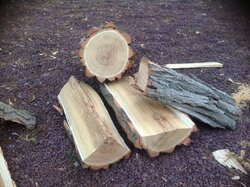Woody Stover
Minister of Fire
Pretty sure that's not Locust. Have you got some examples that you did get split? Pics of fresh end grain (if you've got a saw) and fresh splits might help us with ID. Does the wood have a distinctive smell when split?
I happened to think, if you have a smaller round and no chain saw, maybe cut part of the end with a bow saw, then chip off the sawed piece with a maul to expose the end grain for pics?
I happened to think, if you have a smaller round and no chain saw, maybe cut part of the end with a bow saw, then chip off the sawed piece with a maul to expose the end grain for pics?


